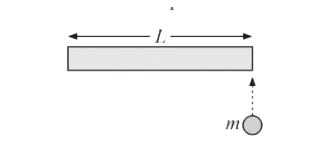A ball of mass m moves with speed v and stricks a wall having infinite mass and it returns with same speed then the work done by the ball on the wall is
Zero
mv J
m/v J
v/m J
The correct Answer is:A
To solve the problem of the work done by a ball of mass m moving with speed v when it strikes a wall of infinite mass and returns with the same speed, we can follow these steps:
Step 1: Understand the scenario
The ball is moving towards a wall and collides with it. The wall is considered to have infinite mass, which means it does not move or change its velocity when the ball strikes it. After the collision, the ball returns with the same speed v.
Step 2: Calculate the initial kinetic energy of the ball
The initial kinetic energy (KE_initial) of the ball before it strikes the wall can be calculated using the formula:
\(
KE_{\text{initial}} = \frac{1}{2} mv^2
\)
Step 3: Calculate the final kinetic energy of the ball
After the collision, the ball returns with the same speed v. Therefore, the final kinetic energy (KE_final) of the ball is:
\(
KE_{\text{final}} = \frac{1}{2} mv^2
\)
Step 4: Determine the work done by the ball on the wall
The work done (W) by the ball on the wall can be calculated using the change in kinetic energy:
\(
W = KE_{\text{final}} - KE_{\text{initial}}
\)
Substituting the values from steps 2 and 3:
\(
W = \frac{1}{2} mv^2 - \frac{1}{2} mv^2 = 0
\)
Conclusion
The work done by the ball on the wall is zero. Thus, the answer is:
\(
\text{Work done} = 0
\)
The ball is moving towards a wall and collides with it. The wall is considered to have infinite mass, which means it does not move or change its velocity when the ball strikes it. After the collision, the ball returns with the same speed v.
The initial kinetic energy (KE_initial) of the ball before it strikes the wall can be calculated using the formula:
\(
KE_{\text{initial}} = \frac{1}{2} mv^2
\)
After the collision, the ball returns with the same speed v. Therefore, the final kinetic energy (KE_final) of the ball is:
\(
KE_{\text{final}} = \frac{1}{2} mv^2
\)
The work done (W) by the ball on the wall can be calculated using the change in kinetic energy:
\(
W = KE_{\text{final}} - KE_{\text{initial}}
\)
Substituting the values from steps 2 and 3:
\(
W = \frac{1}{2} mv^2 - \frac{1}{2} mv^2 = 0
\)
The work done by the ball on the wall is zero. Thus, the answer is:
\(
\text{Work done} = 0
\)
Topper's Solved these Questions
- DAILY PRACTICE PROBLEMBOOK - RESONANCE ENGLISHCHAPTER - DAILY PRACTICE PROBLEMEXERCISE - DPP No.37
9 Videos
- DAILY PRACTICE PROBLEMBOOK - RESONANCE ENGLISHCHAPTER - DAILY PRACTICE PROBLEMEXERCISE - DPP No.38
20 Videos
- DAILY PRACTICE PROBLEMBOOK - RESONANCE ENGLISHCHAPTER - DAILY PRACTICE PROBLEMEXERCISE - DPP No.35
20 Videos
- CURRENT ELECTRICITYBOOK - RESONANCE ENGLISHCHAPTER - CURRENT ELECTRICITYEXERCISE - High Level Problems (HIP)
19 Videos
- ELECTRO MAGNETIC WAVESBOOK - RESONANCE ENGLISHCHAPTER - ELECTRO MAGNETIC WAVESEXERCISE - Exercise 3
27 Videos
Similar Questions
A ball of mass 0.5kg moving with a velocity of 2m/s strikes a wall normally and bounces back with the same speed . If the time of contact between the ball and the wall is 1 millisecond , the average force exerted by the wall on the ball is
View SolutionA ball of mass 0.5kg moving with a velocity of 2m/s strikes a wall normally and bounces back with the same speed . If the time of contact between the ball and the wall is 1 millisecond , the average force exerted by the wall on the ball is
View Solution
Knowledge Check
A ball of mass m collides with a wall with speed v and rebounds on the same line with the same speed. If the mass of the wall is taken as infinite, then the work done by the ball on the wall is
Amv2B12mv2C2mvDzeroA ball of mass m strikes a rigid walJ with speed u and rebounds with the same speed. The impulse imparted to the ball by the wall is
A2muBmuCzeroD−2muA ball of mass m strikes a rigid walJ with speed u and rebounds with the same speed. The impulse imparted to the ball by the wall is
 Amu sin30∘tB2mu sin30∘tCmu cos30∘tD2mu cos30∘t
Amu sin30∘tB2mu sin30∘tCmu cos30∘tD2mu cos30∘t
When we apply a force on a wall of infinite mass but the wall remains at rest, have we done any work on the wall? Does the wall do work on us?
View SolutionA mass m with velocity u strikes a wall normally and returns with same speed. What is the magnitude of the change in momentum of the body when it returns.
View SolutionA stick of length L and mass M lies on a frictionless horizontal surface on which it is free to move in any way. A ball of mass m moving with speed v collides elastically with the stick as shown in the figure. If after the collision the ball comes to rest, then what would be the mass of the ball?

View SolutionA small ball of mass m collides with as rough wal having coeficient of friction μ at an angle θ with the normal to the wall. If after collision the ball moves wilth angle α with the normal to the wall and the coefficient of restitution is e, then find the reflected velocity v of the ball just after collision.

View SolutionA ball of mass 3kg moving with a speed of 100 m/s, strikes a wall at an angle 60∘ (as shown in figure). The ball rebounds at the same speed and remains in contact with the wall for 0.2 s, the force exerted by the ball on the wall is

View Solution
